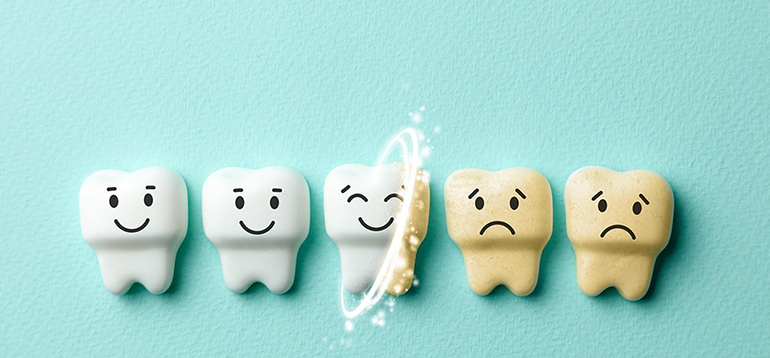STAIN, STAIN , GO AWAY
Most people are conscious of their stained or discolored teeth and most of them go to some length to achieve a whiter, brighter smile. This could include experimenting with variety of toothpastes on the market or some home bleaching kits. Unfortunately, these efforts often fall short of expectations. Some people also attempt to draw attention away from their discolored teeth by cultivating a sun-bed tan or indulging in extravagant and ever-changing hairstyles and make over. Nowadays, there is no longer the need to suffer from social embarrassment due to stained teeth. Suggested cosmetic dental treatment that is safe, pain free and that yields satisfactory and positive long term results is now available.
WHY DO TEETH STAIN?
There are a number of reasons that teeth stain. Your teeth can become discolored by stains on the surface or by changes inside the tooth. There are three main types of tooth discoloration:
- Extrinsic — This is caused when the outer layer of the tooth (the enamel) is stained. Coffee, wine, cola or other drinks or foods can stain teeth. Plaque (a sticky deposit on teeth) can build up on teeth and cause stains. Smoking also causes extrinsic stains.
- Intrinsic —These stains occur in the internal structure of the tooth (the dentin) darkens or gets a yellow tint. You can get this type of discoloration if:
- You were exposed to excess fluoride in water during early childhood.
- Your mother had used tetracycline antibiotics during the second half of pregnancy.
- You had trauma that affected a tooth bud when you were a young child. A fall, for example, may damage the developing permanent tooth bud.
- You had trauma in a permanent tooth, and internal bleeding discolored the teeth.
- Age-related — This is a combination of extrinsic and intrinsic factors. Dentin naturally yellows over time. The enamel layer gets thinner with age, which allows the dentin to show through. Certain foods and smoking also can stain teeth as people get older.
HOW DO YOU DETECT?
They can range from white streaks to yellow tints or typically brown spots and pits. If the enamel has worn away, and dentin is showing through, you may notice a yellow tint. Symptoms include tooth sensitivity, dark whitish areas around the gum line.
No special tests are needed. A dentist or other dental professional can diagnose tooth discoloration oral examination.
WHAT CAN BE DONE TO GET RID OF TOOTH STAINS
From your side:
The best way to avoid extrinsic stains is to brush your teeth right after eating foods that can cause stains, and to make sure you’re brushing your teeth at least twice a day and flossing. Also, limit the consumption of tooth-staining foods and beverages.
When you do consume such foods and beverages, you can mitigate their effects in several ways. Drink tea or coffee through a straw. The same applies for fruit juices, sports drinks, and soda and other carbonated beverages—use a straw whenever possible.
SOLUTIONS
Polishing
Polishing can eliminate many minor surface stains.It is the best option if you:
- Have only slight surface staining
- Want a natural look
- Want to invest a minimum amount of time and money
It is the simplest method of stain removal.In this painless procedure,your dentist applies a paste to the teeth surfaces using a rotating instrument.
Microabrasion
Enamel microabrasion is a technique that can be used to correct discoloured enamel.It is a more advanced form of polishing that can be used for deeper stains.
Bleaching
Over the past two decades, tooth bleaching has become one of the most popular esthetic dental treatments. Bleaching is an oxidation reaction. Tooth bleaching is ‘removal of intrinsic or acquired discolorations of natural teeth through the use of chemicals, in combination with the application of auxiliary means.
Tooth bleaching agents come under four categories: professionally applied (in the dental office); dentist-prescribed (patient home-use); patient purchased/over-the-counter (OTC) (applied by patients); and other options. Current tooth bleaching materials are based mainly on either hydrogen peroxide or carbamide peroxide.
The enamel to be bleached donates electrons to the bleaching agent.2 10% of carbamide peroxide breaks down into 3% hydrogen peroxide and 7% urea. The hydrogen peroxide metabolizes into water and free radicals of oxygen. These free radicals possess only one electron, which combines with the chromogens to decolourize or solubize them.
MAKE THE MOST OF BLEACHING!
If possible lie or sit in the sunlight with your mouth open after bleaching.The tooth structure will actually absorb some of the sunlight, which allows the bleach to continue working.
When performing home bleaching, avoid consuming citrus fruits and juices, soft drinks and antacids.They may slow down the bleaching process and cause mild irritation to the tissues.
Decrease your intake of refined sugars to reduce the chance of decay.
IN OFFICE BLEACHING
The treatment steps followed for bleaching teeth in the office depend on whether your teeth have undergone root canal therapy.It is the most effective way of lightening your teeth because the agents are effective and the procedures more controlled compared with OTC bleaching kits.
If you have never had root canal therapy
Your dentist will isolate the teeth being treated, which protects the gums from discomfort and irritation.The outside of the teeth will be coated with a chemical solution and may be exposed to heat and/or light for 20 to 30 minutes.
If you have undergone root canal therapy
The root canal treated tooth will be reopened, a bleaching solution placed inside and canal resealed with a temporary filling
Heat and/or light can be used at the dental office to accelerate the bleaching process.
PROFESSIONAL HOME BLEACHING
Your dentist can provide you with a customized professional bleaching kit you can use at home.
This is called home bleaching, matrix bleaching or vital bleaching.
You will place a drop of bleaching gel per tooth in the plastic tray.The tray will fit over your teeth and typically will need to be kept in place for 1 to 3 hours each day depending on your dentist’s recommendation.
Home bleaching can have adverse side effects, including tooth sensitivity, a burning sensation of gums, soft tissue ulcers.
Bonding
Dental bonding is a procedure in which a tooth-colored resin material (a durable plastic material) is applied and hardened with a special laser light, which ultimately “bonds” the material to the tooth surface to restore or improve a person’s smile.
The bonding process: The surface of the tooth will be roughened and a conditioning liquid applied. This step helps the bonding material adhere to the tooth. The tooth-colored, putty-like resin material is then applied, molded, and smoothed to the desired shape. A bright, usually blue light, or laser is then used to set the material hard. After the material is hardened, your dentist will further trim and shape it, and polish it to match the sheen of the rest of the tooth surface.
Porcelain Veneers
Masking tetracycline stains is one of the ultimate tests for porcelain veneers. It is difficult to mask dark underlying tooth colour and retain a natural appearance of the veneers. A very important factor in successfully treating these stains is the area of each tooth that is affected. Staining of the incisal third(part of tooth away from the gum) or the middle third of the teeth is relatively easy to treat. Staining in the gingival third(near the gum line) is a difficult situation for veneers.
Since veneers are individually sculpted for each patient, it is nearly impossible to identify the difference between a veneer and a natural tooth. Unlike natural teeth, custom-made veneers resist coffee and tea stains, and cigarette smoke because they are made of highly durable and resistant materials.
Crowns
Placing crowns is a more costly and time consuming option compared with other solutions.Crowns may be the best option if you:
- Have many large defective fillings
- Want the most esthetic and longest-lasting results
- Are looking for a complete smile makeover
- Have discolored teeth that also need some realignment
By making a few simple lifestyle changes, you may be able to prevent tooth discoloration. If your teeth appear to be an abnormal color without ready explanation and, if other symptoms are also present, make an appointment with Dr Vishwas Madan.


